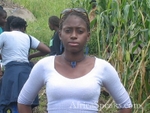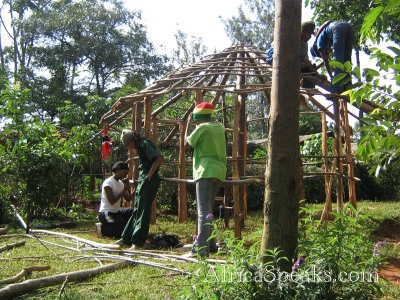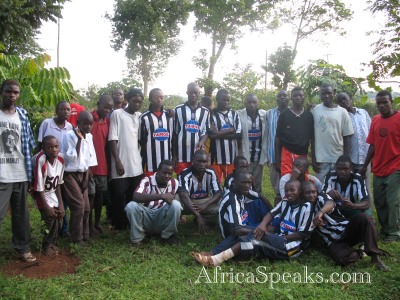The original URL of this article is:
www.africaspeaks.com/kenya/21082006.html
My Sojourn in Kenya
Continuation from: Week One and Week Two
 | | | Renee Alfred | |
An account of the trip to
Bungoma and Kakamega, Kenya
by Renee Alfred
of the faculty of Medical Sciences,
the University of the West Indies
August 21, 2006
UWI Students Trip to Kenya
WEEK THREE
June 23rd – Mwibeleney Primary School and Shiakhongo Primary School
June 24th – Faruha Women's Group, Mwundeshi Women's Group,
Lady Guy Seventh Day Adventist Group
and Ematutu Children's Orphanage
June 25th – Church and Bora Bora Football Club
June 26th – Tea Factory and Tabo Hill Primary School
June 27th – Nyango'ri Boys Boarding School and
Meeting of the National AIDS Control Committee
June 28th – St. Augustine Mukumu Primary Boarding School
June 29th – Western University College of Science and Technology (WUCST)
This week we continued our work in agro-forestry. We actually started and completed the mud hut in two days from scratch. That is, we mixed the mud with feet; we cut the grass for the roof, cut down and shaved mature trees for the foundation and younger trees for the frame of the hut itself.
 | | Building a Traditional Hut |
We also continued our visits to schools educating the children on different career options
and opportunities for higher learning. We learnt about their interests and the challenges they are faced with. This week also, we had a bit of diversity in the age groups of students we dealt with which made the experience even more interesting. Tabo Hill Primary School was only started a few years ago and so out of the eight standards most primary schools have, they only have students up to standard five. This would make the oldest child around the age of eleven. However, most students were within the age range of six to nine years. This was actually quite refreshing for most of us as the approach to these children was quite different and interactive.
At the high school we visited we also opted for a more participative way of doing things and after a general introduction of ourselves to the students we divided the school by way of career preference. So this landed me with all the students that wanted to become medical doctors in the future. This was a very enlightening exercise as students openly shared their experiences with me and their questions about the academic requirements to pursue medicine at my university. I also warned them of the importance of servitude and balance in the medical profession. This was particularly appealing to them as most of them had some extra curriculum activity that they were serious about. Whether it is sport or cultural I warned them that one activity must not suffer on the account of the other and that academic achievements as well as being an all-round student are key to being accepted to any university.
As far as the community outreach aspect of our mission was concerned, we visited and were introduced to a number of self help groups in the area. To ease our schedule a bit we divided our delegation into two groups The first group visited the Faruha Women's group and the Mwundeshi Women's Group while the second group visited the Ematutu Children's Orphanage and Lady Guy Seventh Day Adventist Group. I was in the first group and we visited the two organizations both of whom consisted of villagers that were members of the same Baptist Church. Both groups are also agriculturally based and were organized with the common ground of improving the standard of living of its members by providing a long-term avenue for earning a reasonable livelihood.
The Faruha Women's group had a poultry project as well as a brick production line. On the other hand the Mwundeshi group planted Mulberry trees, cassava and spinach. The capital for these groups was built firstly by members being allotted land then by them pooling their resources to acquire seedlings and other needs. Then the money acquired through sales is used to pay the group members. This is actually a very good idea and it depicts to some extent exactly what is meant by self-help.
We also played a friendly match with the Bora Bora Football club. I have to admit we were all a little intimidated by this team. For one they were about twice the size of our U.W.I. team. They were also in full gear some even complete with tugs while some players on our team opted to play bare feet. Lastly, there was a massive crowd of supporters all around the periphery of the immense field. We still went boldly in our red tops and rhythm section complete with drums and soca warriors' chants. We even had two Kenyan players on our side. At the end of the day we had a lot of fun interacting with the people and to top that off we won two goals to one.
This week we traveled to Kisumu as well. This was about three hours away from Kakamega. This time we went to tour one of Kenya's tea factories. On the journey, aside from the amazing sites, it was particularly interesting to watch the change in the agricultural focus shift from maize to tea. While at the factory we learnt the procedure by which tea is manufactured from the fields to the actual tea bag. We also saw the different grades of tea produced: the highest and most refined of which was used for export and the lowest of which is used locally.
The medical students were lucky enough this week to be invited to take part in a conference of the National AIDS Control Committee (NACC). This conference took place at the St. Nicholas Stam in Kakamega which happened to be the same facility at which we resided while in Kakamega. Unfortunately, we were only able to attend the last of their three or so meetings. Fortunately, we were able to make up for that by making links to acquire information as well as carrying out a short interview with Mr. Ondeng who has worked with the Kenyan NACC for a number of years and was the co-coordinator of the conference. The conference basically gave representatives of different organizations geared towards the fight of HIV/AIDS in the district a chance to air their concerns and tell of their requirements (equipment, transportation, space, and staff). Also, these organizations presented their plans and activities for the upcoming year. A comprehensive report, Community Based Program Activity Report (COBPAR), was also presented to them from the NACC so that they could efficiently chart their progress as far as conducting their activities were concerned. These activities would fall under the NACC's Monitoring and Evaluation Program.
At the Western University of Science and Technology we maintained our successful method of mingling and being open to new personalities. Upon our arrival at the university college we were given a tour of the compound upon which a few students accompanied us, making us feel not so much as outsiders but more like students, just like themselves. After the tour was completed we all assembled in a conference room for an official welcome. We were joined by most of the administrative staff of the university college, inclusive of many of the lecturers of the three faculties. They all gave us a brief insight into their faculty and exactly what they are trying to achieve. We were also given some ideas and areas of interest for possible links between our both universities in the future. One of them was in the field of medical research. It involves the last known equatorial forest in the world located in Kenya and its use in raw materials for pharmaceuticals.
 | | Bora Bora Football Team |
WEEK FOUR
June 30th – Kakamega to Bugoma
June 01st – Kakamega Library, Tree Nursery
June 02nd – U.W.I in house sessions, meetings and discussions
June 03rd – Back to Kakamega
June 04th – Bungoma to Nairobi
June 05th – Nairobi to Dubai and Dubai to London
June 06th – London to Tobago
This week we tried to tie up loose ends and persons from the different faculties tried to get last bits of information for our reports and research questions. We went to the library in Kakamega twice, visited a tree nursery, went back to the Kakamega and Bungoma District Health Offices and went to Bungoma Town all for the last time before leaving. We also had some in house sessions where we learnt about ethnographic report writing and research. We also started planning for next year's trip by setting up a follow up committee. Finally, we went through the entire list of schools and self help groups that we visited and analyzed each group's situation, their needs and ways in which we could help them directly or offer follow up assistance when the other group of students arrives next year. We decided on given assistance in providing building materials for desks and classrooms in some schools while others will receive the addresses of schools interested in forming links via pen pals. The Bora Bora Football group was particularly impressive and as reiterated by its coach, it provides an alternative means for young males to use their time and talent as opposed to the negatives of drug and substance abuse. We decided that we would assist in acquiring much needed equipment for them next year.
As a grand finale to our visit, the Malaho family slaughtered a lamb in our honour. It was then explained to us by Mrs. Malaho that in their culture this act is an expression of appreciation and genuine acceptance of your guest into your household and into your heart. What was heartening is that all the volunteers and villagers that we met everyday embraced us wholeheartedly and sincerely.
Back to Week One and Week Two
UWI Students Trip to Kenya in pictures:
http://rastafarispeaks.com/gallery/Trip_to_Africa_2006
|
|